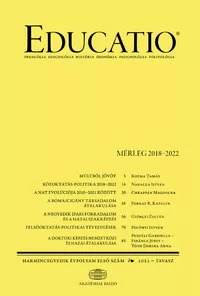A hazai cigányság területi-társadalmi megjelenítése a tankönyvekben. A tankönyvszerző dilemmái
Territorial and Social Representation of The Hungarian Gypsies in Textbooks – The Textbook Author’s Dilemmas
Author(s): Tibor Cserti CsapóSubject(s): Ethnic Minorities Studies
Published by: Akadémiai Kiadó
Keywords: origin of Roma; Roma self-assertion; Roma identity; schoolbooks of public education;
Summary/Abstract: During a research in 2015 on the representation of Roma culture among content regulators and content carriers, as well as their development opportunities, we investigated whether the optional textbooks for teaching in public education contain relevant information about the domestic nationalities, with a focus on the Roma population, which could be mandatory elements of the basic knowledge material according to the requirements of the Hungarian National core curriculum, the Framework Curricula, and the local curricula based on them. (see Orsós 2015, 2016; Csapó Cserti 2016; Andl– Cserti 2017) In the research we reviewed the results of previous studies on this topic (Terestyéni 2004; Balázs et al. 2014; Binder–Pálos 2016). The first examination of the textbooks ended with very negative experiences. The optional textbooks rarely contained information about nationalities in Hungary, and among them, this neglect was even more noticeable in relation to Roma. Despite the fact that each subject is suitable for meeting the content and sensitization expectations for national minorities set out in the curricula, it conveys social acceptance and a multicultural approach. Contents were published just in some of the examined textbooks, but these were without exception either inaccurate or rather hid the danger of deepening stereotypical thinking. It also became clear how difficult task it is for the textbook author to simultaneously meet the curriculum requirements of the education policy, the age characteristics and previous professional knowledge of the students, the professional expectations of the teachers society, and the content, visual and didactic expectations of textbooks (see Dárdai 2002; Balázs et al. 2017), together with social and parental needs, the actual school frameworks and possibilities of teaching geography should also be taken into account (e.g. number of lectures, professional knowledge of practicing teachers, their social sensitivity, etc.). From this latter point of view, the study reflects on what and how can be taught from the “customer’s package” required by the domestic education policy in relation to the socio-economic-territorial approach of the nationalities, including the Roma population.
Journal: Educatio
- Issue Year: 32/2023
- Issue No: 2
- Page Range: 304-317
- Page Count: 14
- Language: Hungarian

